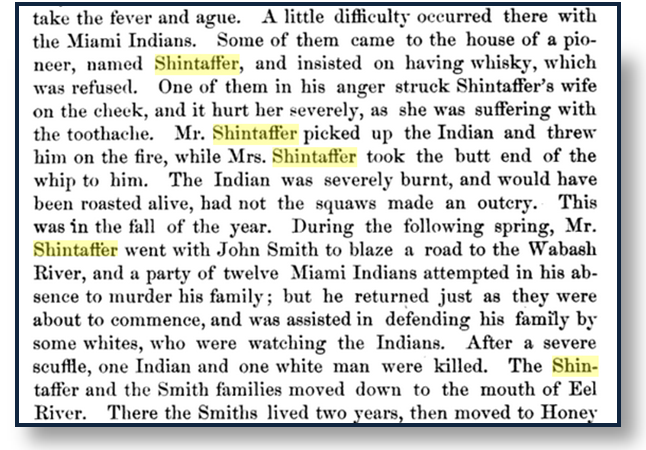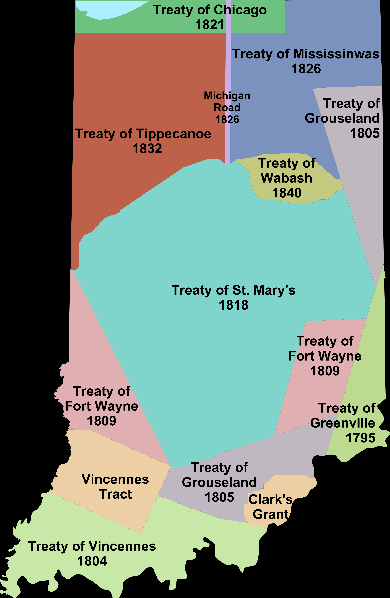A version of this appeared in the Hamilton County Business Magazine – January 27, 2012.
When doing historical research, it’s easy to find yourself investigating unexpected paths. The murder of Benjamin Fisher is one such case. While examining the War of 1812 and its presence in Hamilton County, I came across Fisher’s story in the local histories. The more I looked at the case, which is considered the first known murder in the county, I began to wonder about many of the tales about it that have been passed down through the years.
The murder happened in Strawtown, which was a lively place at that time. It was the intersection of the Lafayette Trace – which ran from the Whitewater Valley to the Wabash River at Tippecanoe – and the trail that followed the White River from southern Indiana. The area was a convenient stopping point for travelers along the trails. A distillery and horse racing track were among the first businesses. At this point in time, Hamilton County had not been established and the area was still part of the Delaware New Purchase.

I was unable to locate contemporary accounts of the murder – the earliest version available is from 1874, some 53 years after the incident. Fisher himself was born in 1791 in Pennsylvania and moved to Indiana after serving in War of 1812. He was an early settler of the Fishersburg area, which would be named for him, in Madison County.
The cause of the incident was a man named Philip Shintaffer (1776-1840), who ran a tavern in Strawtown, (mostly known as a gin mill), and who made his money by selling liquor to American Indians. Later writers described him as a “notorious character.”
The standard version of the story begins in March of 1821 when Shintaffer got into an argument with one of the local Native Americans – supposedly about watering the liquor. Shintaffer knocked the Native American down and threw him into the fireplace, where he was severely burned and possibly died. The repercussions of the incident were felt in April, when Benjamin Fisher and other farmers traveled to Strawtown to get axes sharpened at Shintaffer’s (who had the only grindstone in the area). A group of American Indians, possibly Miami or Pottawatomie, came to revenge themselves on Shintaffer for his actions the month before. Armed with knives and tomahawks, they attacked the tavern. The farmers responded with axes and whatever was at hand. They held off the Native Americans until Shintaffer was wounded and Fisher brained by a tomahawk. One Native American was killed, at which point the group fled.

This narrative has been repeated for many years. Versions exist from possibly Shintaffer himself (second- or third-hand), Benjamin’s daughter Mary Fisher Simmerman (1816-1884), and Benjamin’s son Charles Fisher (1819-1912). One might assume these are reliable sources, despite Fisher’s children being quite young when the incident occurred. However, oddities and discrepancies emerge when the story is analyzed by a historian. They include:
1) Different versions vary regarding the number of parties involved, but it generally comes out as 4 to 6 farmers holding off 8 to 12 American Indian warriors. When one farmer was down and another wounded, the Indians abandoned the attack without completing what they came to do. This is pretty impressive hand-to-hand fighting skills on the part of the farmers and seems somewhat unlikely.
2) No guns were used – the Indians allegedly wanted silence, but nothing prevented one of the farmers from stepping into the trading post and picking up a firearm.
3) For unknown reasons, Fisher was buried in Strawtown, where he died – not sent home to his family and his own property, which was only about eight miles away. There was no official burial ground at that time in Strawtown and no reason why that site would have been preferred. The grave was apparently left unmarked. Later historians would mention a “low mound” with no headstone near what would become the Strawtown Cemetery. It could possibly be located with modern archeological techniques.
4) The night after the killing, Shintaffer packed all of his goods and his family into a canoe and left the area. He followed White River to Greene County and settled there for a few years. The histories there refer to him a man of “considerable notoriety” having a “quick temper” and often being the defendant in court cases. He left there in 1832 and finally settled in Cass County, Michigan.
5) Finally, despite this being a sizable attack on an isolated settlement, no record of an official reaction has been found. There was apparently no attempt to capture the perpetrators, even though during the War of 1812, soldiers would chase Native American warriors from Franklin County all the way to the area of modern Hamilton County. In 1824, three years after the Strawtown fight, Governor Ray would call out the militia because of the fears of retaliation for the Massacre on Fall Creek. But in this case – a wholesale assault and battle involving possibly 20 people and two deaths – nothing was said or done that appeared in any official documents.

Some of the people who remained to tell the story were interesting characters. Shintaffer himself was probably the source of the account written down in 1874. One of the alleged participants was Jacob Hire, although he’s not named in the earliest versions. He has a shadowy background and was sometimes partner with Shintaffer in business. He was the person who built the distillery and horse racing track. Later, he became Overseer of the Poor for White River Township, (he had apparently built up a good client base). Another alleged participant was Jacob Colip, but he is also not mentioned in the earliest versions and there is no record of his being in Hamilton County until 1823. No other participants are named.
Charles Fisher, the son of Benjamin, was two years old at the time of the attack. While he was too young to have witnessed anything, he told this story often. He was known for his stories. For example, he said that he had the powder horn that his father carried in the War of 1812. He also said that he had the tomahawk that his father was killed with. And he also said that he had pieces of his father’s skull from the attack and would show these pieces to visitors. (As a side note, Charles was also one of first to say that Strawtown was named for the Delaware Chief Straw, a person that modern historians have found no evidence actually existed.)

In the final analysis, many of the stories don’t appear to hold up and it’s not clear what actually happened. Native Americans have been accused of this crime for over 190 years, even though they gained nothing from it – not even revenge. With the signing of the Treaty of St. Mary’s in 1818, the American Indians were already leaving the state, so the motives in all cases seem a little unclear. No other possibilities seem to have been considered – including the short-tempered, violent man who fled the area immediately after the killing. No matter what else may have happened, Benjamin Fisher was in the wrong place at the wrong time and left a conundrum for future historians.
